1995 CHEVROLET BLAZER engine coolant
[x] Cancel search: engine coolantPage 253 of 380
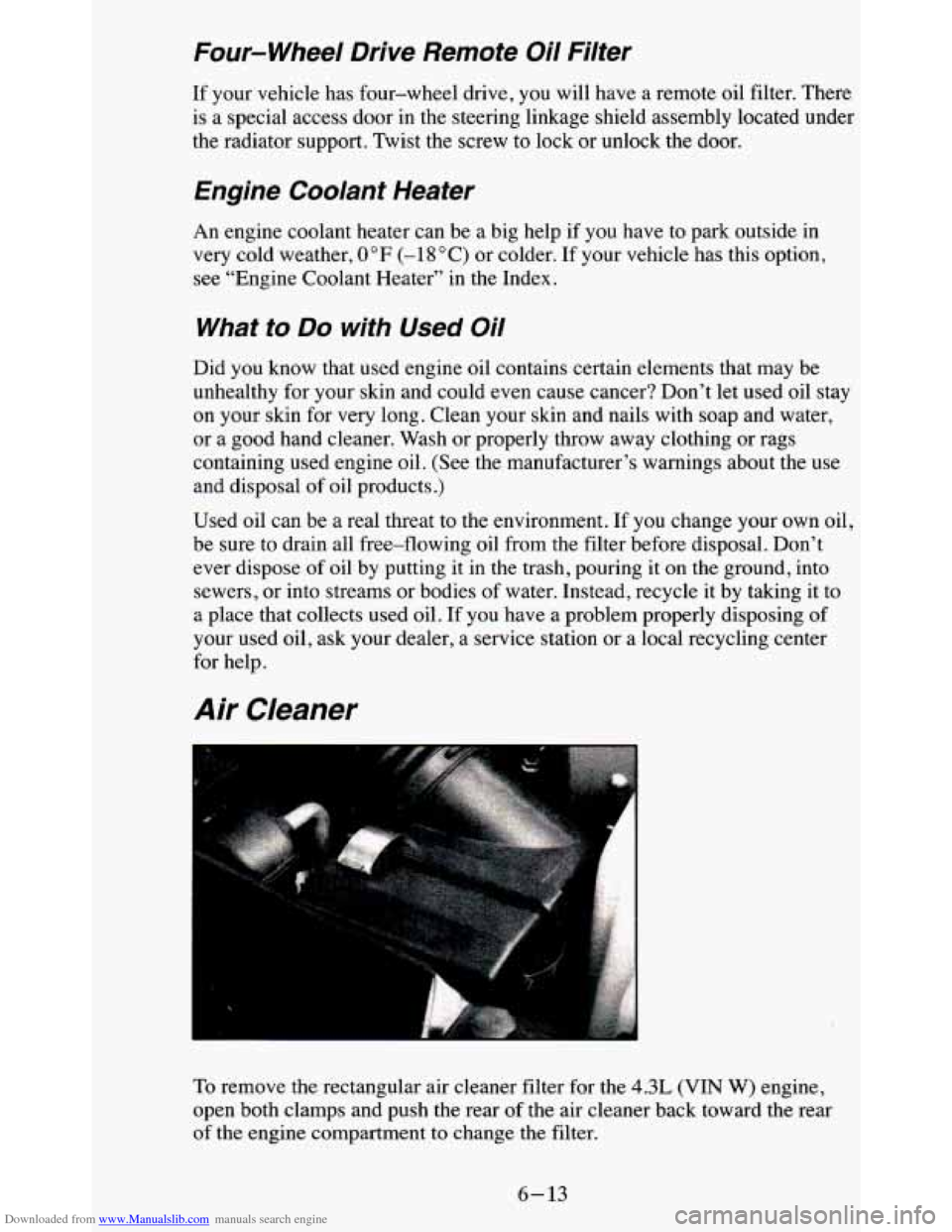
Downloaded from www.Manualslib.com manuals search engine Four-wheel Drive Remote Oil Filter
If your vehicle has four-wheel drive, you will have a remote oil filter. There
is a special access door in the steering linkage shield assembly located under
the radiator support. Twist the screw to lock or unlock the door.
Engine Coolant Heater
An engine coolant heater can be a big help if you have to park outside in
very cold weather,
0°F (-18 “C) or colder. If your vehicle has this option,
see “Engine Coolant Heater” in
the Index.
What to Do with Used Oil
Did you know that used engine oil contains certain elements that may be
unhealthy for your skin and could even cause cancer? Don’t let used oil stay
on your skin for very long. Clean your skin and nails with soap and water,
or a good hand cleaner. Wash or properly throw away clothing or rags
containing used engine oil. (See the manufacturer’s warnings about the use
and disposal of oil products.)
Used oil can be a real threat to the environment. If you change your own oil,
be sure to drain all free-flowing oil from the filter before disposal. Don’t
ever dispose of oil by putting it in the trash, pouring
it on the ground, into
sewers, or into streams or bodies of water. Instead, recycle it by taking
it to
a place that collects used oil. If you have a problem properly disposing of
your used oil, ask your dealer, a service station or a local recycling center
for help.
Air Cleaner
To remove the rectangular air cleaner filter for the 4.3L (VIN W) engine,
open both clamps and push the rear
of the air cleaner back toward the rear
of the engine compartment to change the filter.
6-13
Page 261 of 380
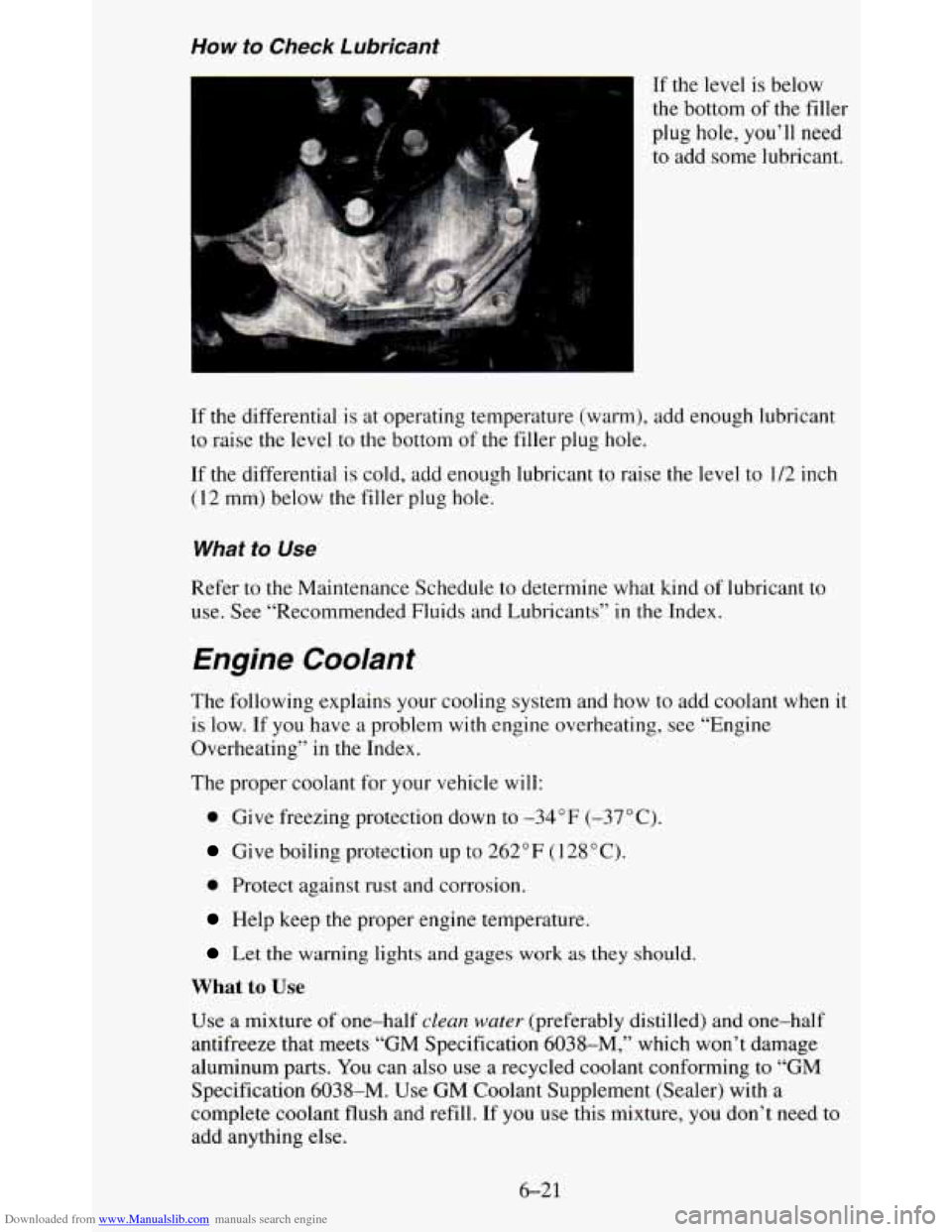
Downloaded from www.Manualslib.com manuals search engine How to Check Lubricant
,:
If the level is below
the bottom
of the filler
plug hole, you’ll need
to add some lubricant.
If the differential
is at operating temperature (warm), add enough lubricant
to raise the level to the bottom of the filler plug hole.
If the differential is cold, add enough lubricant to raise the le\
vel to 1/2 inch
(12 mm) below the filler plug hole.
What to Use
Refer to the Maintenance Schedule to determine what kind of lubricant to
use. See “Recommended Fluids and Lubricants”
in the Index.
Engine Coolant
The following explains your cooling system and how to add coolant \
when it
is low. If you have a problem with engine overheating, see “Engine
Overheating”
in the Index.
The proper coolant
for your vehicle will:
0 Give freezing protection down to -34°F (-37°C).
Give boiling protection up to 262°F (128°C).
0 Protect against rust and corrosion.
Help keep the proper engine temperature.
Let the warning lights and gages work as they should.
What to Use
Use a mixture of one-half clean water (preferably distilled) and one-half
antifreeze that meets “GM Specification 6038-M,” which won’t damage
aluminum parts.
You can also use a recycled coolant conforming to “GM
Specification 6038-M.
Use GM Coolant Supplement (Sealer) with a
complete coolant flush and refill. If
you use this mixture, you don’t need to
add anything else.
6-21
Page 262 of 380
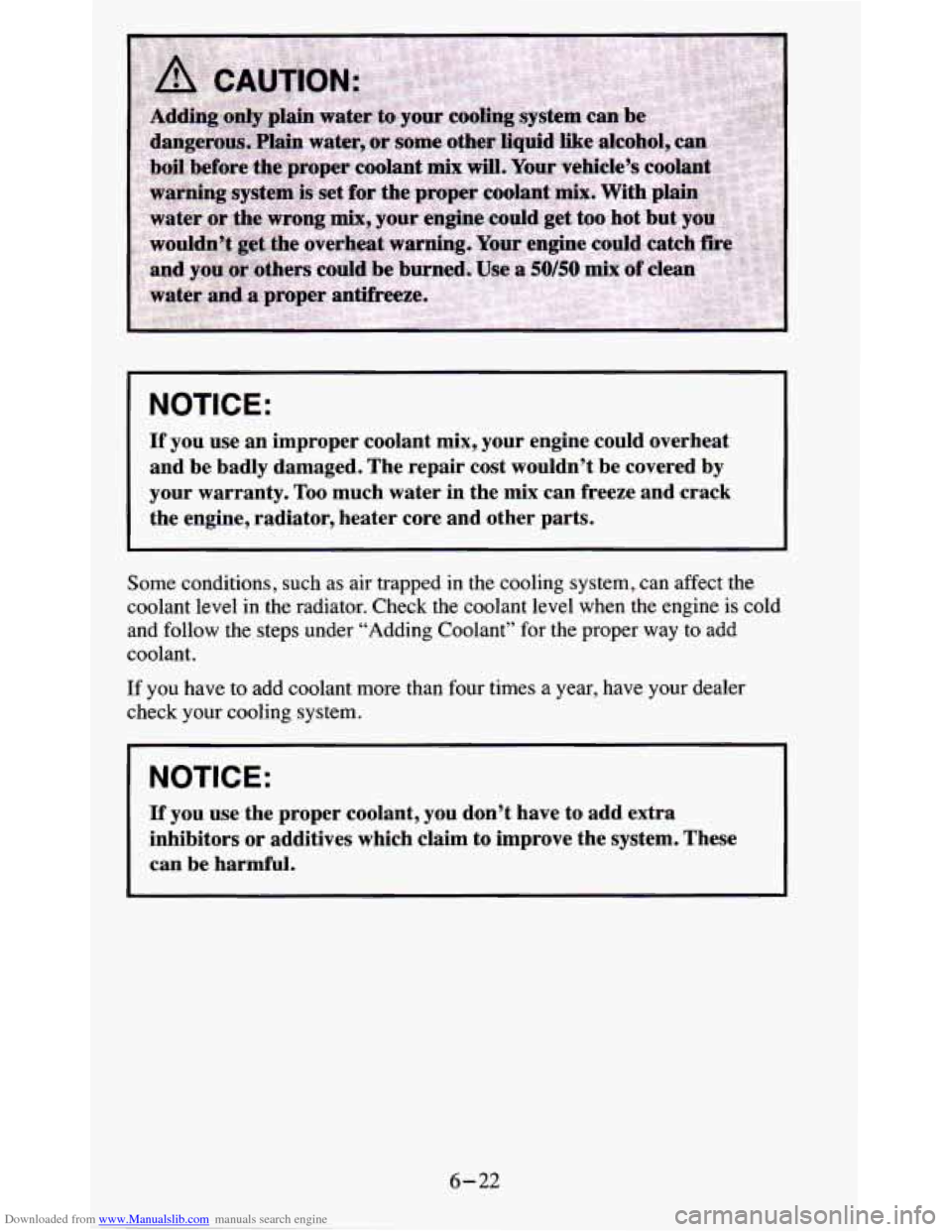
Downloaded from www.Manualslib.com manuals search engine NOTICE:
If you use an improper coolant mix, your engine could overheat
and be badly damaged. The repair cost wouldn’t be covered
by
your warranty. Too much water in the mix can freeze and crack
the engine, radiator, heater core and other parts.
Some conditions, such as air trapped in the cooling system, can affect the
coolant level in the radiator. Check the coolant level when the engine is cold
and follow the steps under “Adding Coolant” for the proper way to add
coolant.
If you have to add coolant more than four times a year, have your dealer
check your cooling system.
NOTICE:
If you use the proper coolant, you don’t have to add extra
inhibitors or additives which claim
to improve the system. These
can be harmful.
6-22
Page 263 of 380
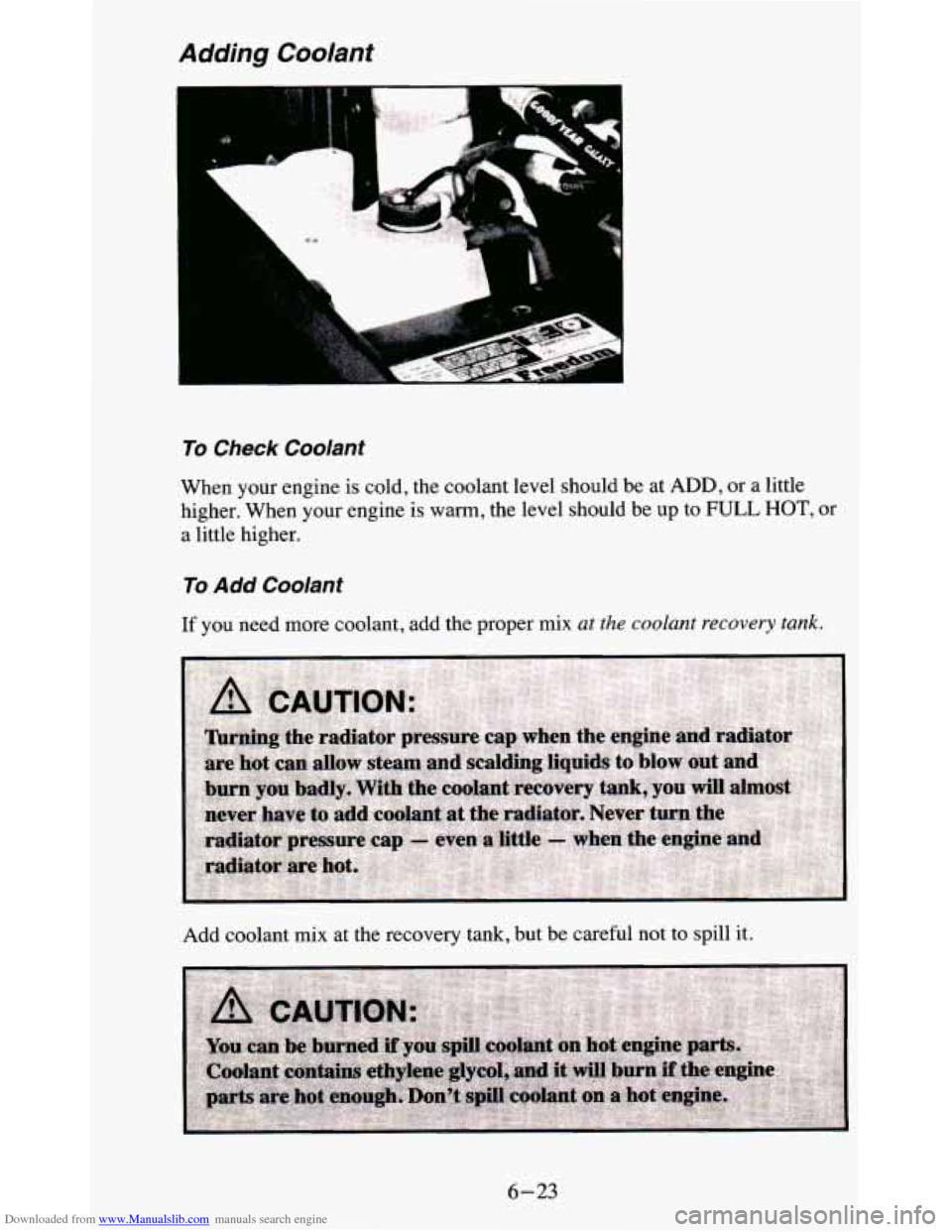
Downloaded from www.Manualslib.com manuals search engine 3dding Coolant
k
To Check Coolant
When your engine is cold, the coolant level should be at ADD, or a little
higher. When your engine is warm, the level should be
UP to FULL HOT, Or
a little higher.
To Add Coolant
If you need more coolant, add the proper mix ut the coolant recovery tank.
Add coolant mix at the recovery tank, but be careful not to spill it.
6-23
Page 264 of 380
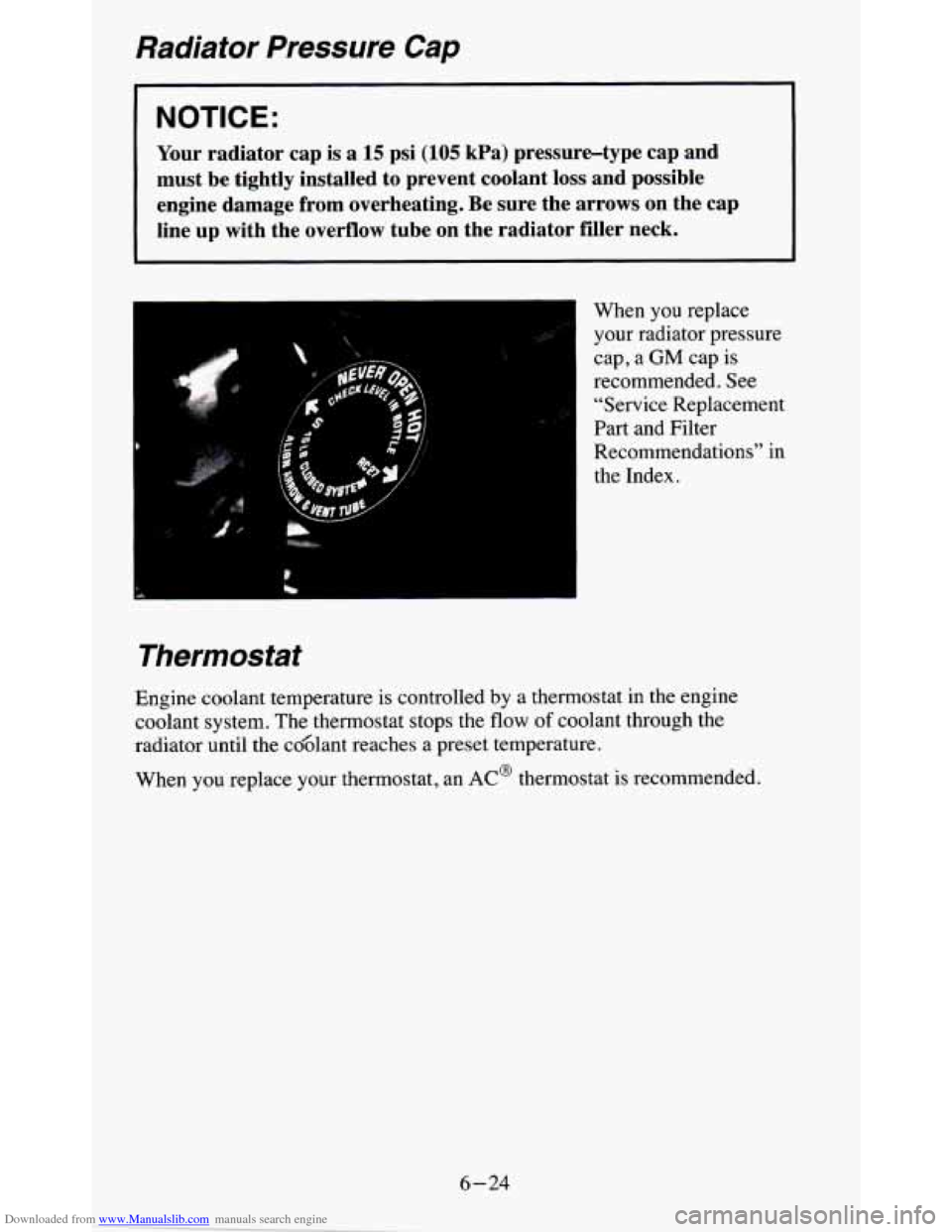
Downloaded from www.Manualslib.com manuals search engine Radiator Pressure Cap
NOTICE:
Your radiator cap is a 15 psi (105 kPa) pressure-type cap and
must be tightly installed to prevent coolant loss and possible \
engine damage from overheating. Be sure the arrows on the cap \
line up with the overflow tube on the radiator filler neck.
When you replace your radiator pressure
cap, a
GM cap is
recommended. See
“Service Replacement
Part and Filter
Recommendations” in
the Index.
Thermostat
Engine coolant temperature is controlled by a thermostat in the engine
coolant system. The thermostat stops the
flow of coolant through the
radiator until the co6lant reaches a preset temperature.
When you replace your thermostat, an
AC@ thermostat is recommended.
6-24
Page 348 of 380
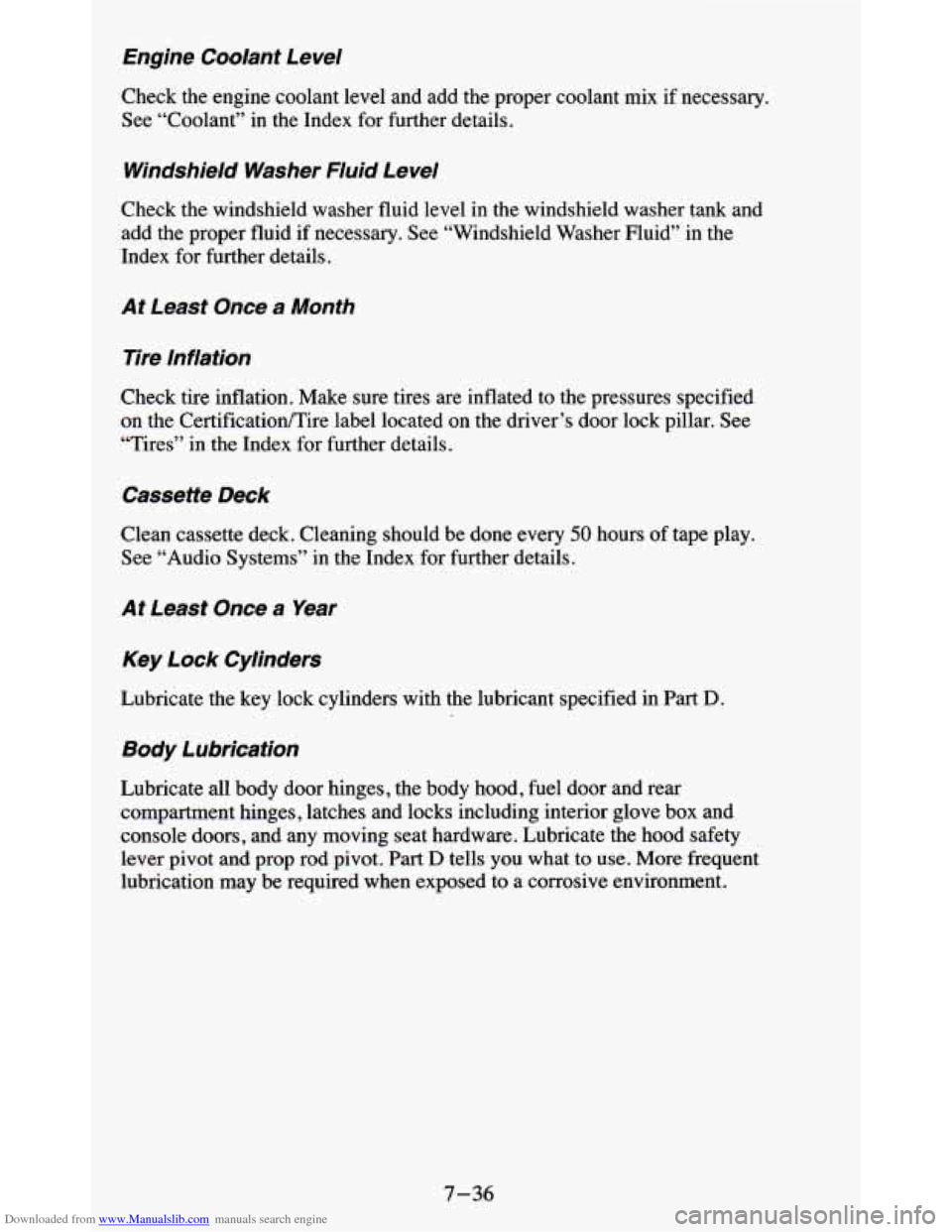
Downloaded from www.Manualslib.com manuals search engine €ngine Coolant Level
Check the engine coolant level and add the proper coolant mix if necessary.
See “Coolant” in the Index for further details.
Windshield Washer Fluid Level
Check the windshield washer fluid level in the windshield washe\
r tank and
add the proper fluid if necessary. See “Windshield Washer Fluid” in the
Index for further details.
At Least Once a Month
Tire Inflation
Check tire inflation. Make sure tires are inflated to the pressures specified
on the Certificatioflire label located on the driver’s door lock pillar. See
“Tires” in the Index for further details.
Cassette Deck
Clean cassette deck. Cleaning should be done every 50 hours of tape play.
See “Audio Systems” in the Index for further details.
At Least Once a Year
Key Lock Cylinders
Lubricate the key lock cylinders with the lubricant specified i\
n Part D.
Body Lubrication
Lubricate all body door hinges, the body hood, fuel door and rear
compartment hinges, latches and locks including interior glove box and
console doors, and any moving seat hardware. Lubricate the hood safety
lever pivot and prop rod pivot.
Part D tells you what to use. More frequent
lubrication may be required when exposed to
a corrosive environment.
7-36
Page 352 of 380
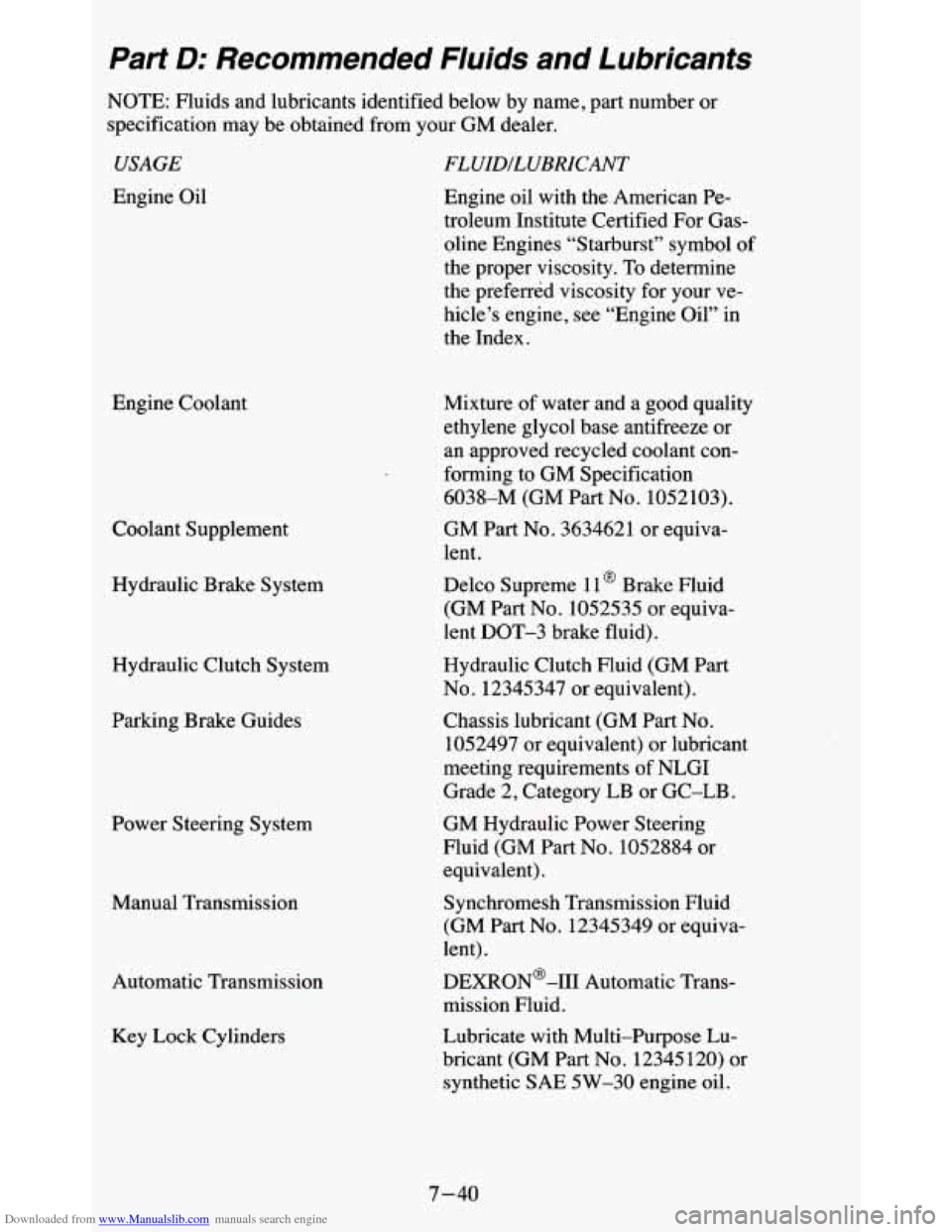
Downloaded from www.Manualslib.com manuals search engine Part D: Recommended Fluids and Lubricants
NOTE: Fluids and lubricants identified below by name, part number or
specification may be obtained from your GM dealer.
USAGE
Engine Oil
Engine Coolant
Coolant Supplement Hydraulic Brake System
Hydraulic Clutch System
Parking Brake Guides
Power Steering System
Manual Transmission
Automatic Transmission
Key Lock Cylinders
FLUIDILUBRICANT
Engine oil with the American Pe-
troleum Institute Certified For Gas-
oline Engines “Starburst” symbol
of
the proper viscosity. To determine
the preferred viscosity for your ve-
hicle’s engine, see “Engine Oil” in
the Index.
Mixture of water and a good quality
ethylene glycol base antifreeze or
an approved recycled coolant con-
forming to GM Specification
6038-M (GM Part
No. 1052103).
GM Part No. 3634621 or equiva-
lent.
Delco Supreme 11
@ Brake Fluid
(GM Part No. 1052535 or equiva-
lent DOT-3 brake fluid).
Hydraulic Clutch Fluid (GM Part
No. 12345347 or equivalent).
Chassis lubricant (GM Part
No.
1052497 or equivalent) or lubricant
meeting requirements
of NLGI
Grade 2, Category
LB or GC-LB .
GM Hydraulic Power Steering
Fluid (GM Part
No. 1052884 or
equivalent).
Synchromesh Transmission Fluid
(GM Part
No. 12345349 or equiva-
lent).
DEXRON@-I11 Automatic Trans-
mission Fluid.
Lubricate with Multi-Purpose Lu-
bricant (GM Part
No. 12345 120) or
synthetic
SAE 5W-30 engine oil.
7-40
Page 370 of 380
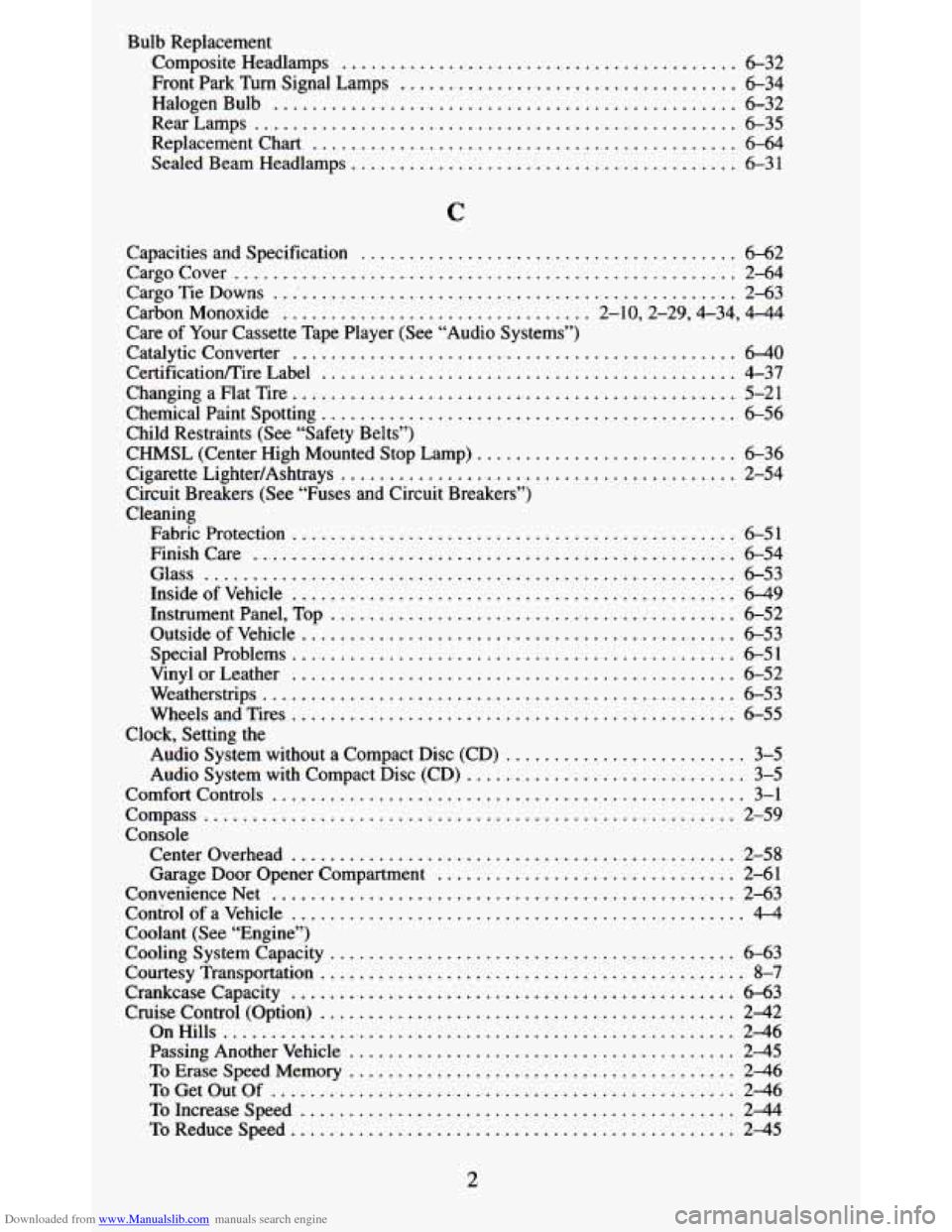
Downloaded from www.Manualslib.com manuals search engine Bulb Replacement Composite Headlamps
......................................... 6-32
Front Park Turn Signal Lamps ................................... 6-34
Halogen Bulb ................................................ 6-32
RearLamps .................................................. 6-35
Replacementchart ............................................ 6-64
Sealed Beam Headlamps ........................................ 6-31
C
Capacities and Specification ....................................... 6-62
Cargocover .................................................... 2-64
Cargo Tie Downs ................................................. 2-63
Carbon Monoxide ................................ 2-10.2-29.4-34. 4-44
Care of Your Cassette Tape Player (See “Audio Systems”)
Catalytic Converter
.............................................. 640
Certificatiomire Label ........................................... 4-37
Changing a Flat Tire .............................................. 5-21
Chemical Paint Spotting ........................................... 6-56
Child Restraints (See “Safety Belts”)
CHMSL (Center High Mounted Stop Lamp)
........................... 6-36
Cigarette LightedAshtrays ......................................... 2-54
Circuit Breakers (See “Fuses and Circuit Breakers”)
Cleaning
Fabricprotection
.............................................. 6-51
Finishcare .................................................. 6-54
Glass ....................................................... 6-53
InsideofVehicle .............................................. 6-49
Instrument Panel. Top .......................................... 6-52
Outside of Vehicle ............................................. 6-53
Special Problems .............................................. 6-51
VinylorLeather .............................................. 6-52
Weatherslips ................................................. 6-53
Wheels and Tires .............................................. 6-55
Audio System without a Compact Disc (CD) ......................... 3-5
Audio System with Compact Disc (CD) ............................. 3-5
Comfort Controls ................................................. 3-1
Compass ....................................................... 2-59
Console
Centeroverhead
.............................................. 2-58
Garage Door Opener Compartment ............................... 2-61
ConvenienceNet ................................................ 2-63
Control of a Vehicle ............................................... 4-4
Coolant (See “Engine”)
Cooling System Capacity
.......................................... 6-63
Courtesy Transportation ............................................ 8-7
Crankcasecapacity .............................................. 6-63
Cruise Control (Option) ........................................... 2-42
OnHills ..................................................... 246
Passing Another Vehicle ........................................ 2-45
To Erase Speed Memory ........................................ 246
ToGetOutOf ................................................ 246
ToIncreaseSpeed ............................................. 24
ToReduceSpeed .............................................. 2-45
Clock. Setting the
2